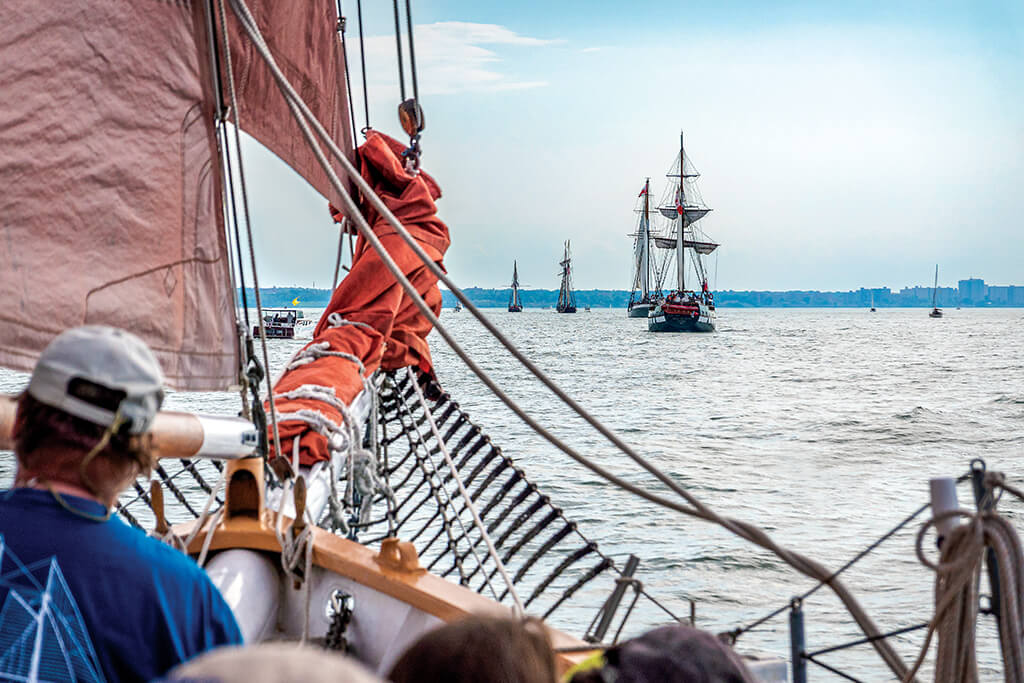Tales of Our Treasured Lake Erie
Dive into the past with fascinating stories of brutal battles, mysterious shipwrecks and the role the Great Lakes played in shaping the world we live in today.

The Great Lakes, as a whole, contain 84% of the available surface freshwater for North America.
“And, there’s a story in every drop,” says Chris Gillcrist, executive director of the National Museum of the Great Lakes, in Toledo.
Since Moses Cleaveland, who surveyed the land that eventually became his namesake city, laid eyes on what was regarded as an inland sea at the mouth of the Cuyahoga River in 1796, Lake Erie had become an integral part of American history.
“The Great Lakes — and Lake Erie in particular — play such a huge role in the cultural landscape — social, political, economic — of the U.S.,” Gillcrist says. “At every stage of America’s historical development, the Great Lakes have been integral in shaping that development.”
The Great Lakes were — and are — important shipping corridors, which made them strategically important in the War of 1812. The most famous event on the Great Lakes in the war took place on Sept. 10, 1813, when the vaunted British Navy met American forces near Put-in-Bay, on South Bass Island in Lake Erie’s western basin.
The Americans, commanded by Commodore Oliver Hazard Perry, had more ships, but they were smaller, and several were sunk initially by the British. But, Perry transferred command to the Niagara and was able to force the British to surrender in what became known as the Battle of Lake Erie. Afterward, Perry sent a message to American Commander William Henry Harrison: “We have met the enemy, and they are ours.”
Lake Erie had an important, if less well-known, role in the run-up to the Civil War. Fugitive Slave Acts made nowhere in the U.S. safe for runaway slaves, and a network including freed slaves and abolitionists formed to guide them to safety: the Underground Railroad. The only safe place was Canada.
“They weren’t crossing the border in North Dakota,” Gillcrist says. “They were coming to Ohio, Pennsylvania, New York and Michigan — which means they typically crossed the Great Lakes or one of their tributaries.
“Many people don’t realize the last stop on the Underground Railroad was usually the hold of a schooner crossing a Great Lake, and that was usually Lake Erie,” Gillcrist adds.
The post-Civil War era saw the rise of industry in American cities — particularly those that provided easy access to shipping. The cities along Lake Erie benefitted. In 1900, Toledo was the third-largest city in Ohio. At the time, Cleveland was still one of the largest oil refining cities in the world, and the Silicon Valley of its day. It was estimated that the city provided more patent applications per capita than any other. Buffalo boasted more millionaires per capita than any other city, its businesses lit by electric power from nearby Niagara Falls. In fact, Buffalo quickly became known as the “Electric City.”
Even small cities became prosperous. Sandusky quickly became known as the ice capital of the Great Lakes, harvesting thick sheets as the lake froze over in the winter. Ashtabula became one of the busiest ports not just in America, but in the world. Lake Erie’s ports even changed the way ships were built. When George Hulett of Conneaut invented an enormous unloading apparatus in 1898, it revolutionized unloading ships. Soon, the Hulett unloaders could be found at just about every port on the Great Lakes, and shipbuilders actually redesigned ships to make unloading more efficient.
When Franklin Roosevelt spoke of the Great Arsenal of Democracy, he was no doubt talking about the cities along Lake Erie. General Electric made howitzers in Erie, Pennsylvania. General Motors made bombers in Cleveland. Bell made aircraft in Buffalo. And of course, the Jeep was made — in enormous numbers — by Willys-Overland in Toledo.
But progress comes at a price. The Great Lakes could sustain life — and just as easily take it away. It’s estimated that there were at least 8,000 shipwrecks across the Great Lakes. That number’s a guess, Gillcrist says. Some ships were raised and reused, and it wasn’t until the 19th century, when wrecks started getting news coverage — and insurance claims — that better records were kept.
Of that 8,000, Gillcrist estimates a quarter occurred on Lake Erie. It’s the southernmost Great Lake, with the busiest travel. Gillcrist said some railroad car ferries would cross the lake two or three times in a single day. It’s also the shallowest of the Great Lakes, he says, so navigation can be difficult.
Also, storms come up in minutes, not hours — like on Oct. 20, 1916. That day, known as “Black Friday,” two pressure systems converged, and combined with what was called a minor hurricane, sank four ships, resulting in the deaths of a total of 49 crew members.
But, because the Great Lakes are freshwater, many of those shipwrecks remain underwater and relatively undisturbed. In 2018, divers were able to locate the Lake Serpent, a ship that had sunk in 1829, identifiable by the carvings on its bow.
There’s one great shipwreck that has eluded divers for more than a century. The Marquette & Bessemer No. 2 set out from Conneaut for Port Stanley, Ontario. The 338-foot-long ship, carrying a load of 30 fully laden railroad cars, never made it. A lifeboat was found, but no trace of ship ever was.
“How can that have not been found in the shallowest and smallest Great Lake?” Gillcrist says. “There are still many shipwrecks to be found, and that’s both the challenge and the excitement for us.”
Made by History: Uncovering Lake Erie's Secrets

From Toledo to Buffalo and everywhere in between, our Great Lake is filled with destinations to learn more about the region's fascinating history.
Story:
Vince Guerrieri
2022 May/June






